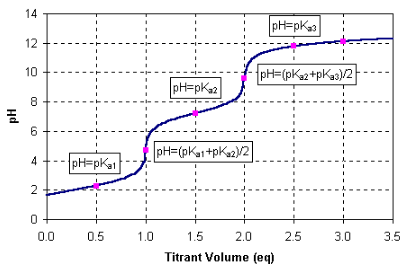Silver_Is_Money
Larry Sayre, Developer of 'Mash Made Easy'
Per this website: http://clymer.altervista.org/buffers/phos2.html
A phosphate based pH 5.4 buffer with a "buffer strength" of 10 mmoles per liter can be generated via the addition to your mash water of:
1) Monosodium Phosphate, Monoyhdrate at 0.1327% by weight of mash water
2) Disodium Phosphate, Heptahydrate at 0.0104% by weight of mash water
Example for a mash in 9 gallons of water:
9 gallons x 3.7854 L/Gal. = 34.07 Liters
Weight of 34.07 Liters of water in grams ~= 1,000 x 34.07 ~= 34,070 grams
34,070 grams x 0.1327/100 = 45.21 grams of Monosodium Phosphate, Monoyhdrate
34,070 grams x 0.0104/100 = 3.54 grams of Disodium Phosphate, Heptahydrate
Disclaimer 1: Please don't shoot the messenger (I.E., me) as I'm only following along with my understanding of how this website would suggest going about creating a 5.4 buffer.
Warning and Disclaimer 2: I have not researched the potential health hazards of either of the compounds being discussed here. Please do so diligently if you are actually considering attempting this. I'm not at all suggesting that you try this. I'm merely presenting it for scientific discussion.
Conclusion (using the websites guidance and my understanding of it, which may be completely wrong):
If 45.21 grams of Monosodium Phosphate and 3.54 grams of Disodium Phosphate are added to 9 gallons of water, it should nominally buffer a mash at a pH of 5.4
I'm guessing that the manufacturer of 5.2 may have used a calculator such as this web based calculator to formulate their 5.2 buffer.... (and I'm well aware that most have concluded that it doesn't work), but again, I'm only tossing this out as the messenger, and for open discussion.
A phosphate based pH 5.4 buffer with a "buffer strength" of 10 mmoles per liter can be generated via the addition to your mash water of:
1) Monosodium Phosphate, Monoyhdrate at 0.1327% by weight of mash water
2) Disodium Phosphate, Heptahydrate at 0.0104% by weight of mash water
Example for a mash in 9 gallons of water:
9 gallons x 3.7854 L/Gal. = 34.07 Liters
Weight of 34.07 Liters of water in grams ~= 1,000 x 34.07 ~= 34,070 grams
34,070 grams x 0.1327/100 = 45.21 grams of Monosodium Phosphate, Monoyhdrate
34,070 grams x 0.0104/100 = 3.54 grams of Disodium Phosphate, Heptahydrate
Disclaimer 1: Please don't shoot the messenger (I.E., me) as I'm only following along with my understanding of how this website would suggest going about creating a 5.4 buffer.
Warning and Disclaimer 2: I have not researched the potential health hazards of either of the compounds being discussed here. Please do so diligently if you are actually considering attempting this. I'm not at all suggesting that you try this. I'm merely presenting it for scientific discussion.
Conclusion (using the websites guidance and my understanding of it, which may be completely wrong):
If 45.21 grams of Monosodium Phosphate and 3.54 grams of Disodium Phosphate are added to 9 gallons of water, it should nominally buffer a mash at a pH of 5.4
I'm guessing that the manufacturer of 5.2 may have used a calculator such as this web based calculator to formulate their 5.2 buffer.... (and I'm well aware that most have concluded that it doesn't work), but again, I'm only tossing this out as the messenger, and for open discussion.
Last edited:

































![Craft A Brew - Safale S-04 Dry Yeast - Fermentis - English Ale Dry Yeast - For English and American Ales and Hard Apple Ciders - Ingredients for Home Brewing - Beer Making Supplies - [1 Pack]](https://m.media-amazon.com/images/I/41fVGNh6JfL._SL500_.jpg)













